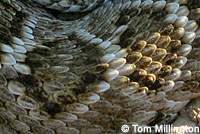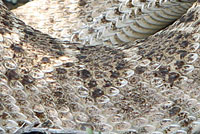Observable Differences Between
Western Diamond-backed Rattlesnake - Crotalus atrox
&
Red Diamond Rattlesnake - Crotalus ruber

 Red Diamond Rattlesnake - Crotalus ruber
Red Diamond Rattlesnake - Crotalus ruber Western Diamond-backed Rattlesnake - Crotalus atrox
Western Diamond-backed Rattlesnake - Crotalus atrox
| The tail rings and head appearance is similar for both species so these characteristics can't be used to identify the species, but some the characteristics below might help. |
||
| Range | ||
For the most part, the ranges of the two species do not overlap so you can use the range maps to determine the species. However, there is a slight overlap in range in Imperial County and there may also be a slight overlap in Riverside County. There may also be an overlap in range in San Diego County, but so far there is no conclusive evidence to support this. (See comments below.) |
||
Color |
||
Generally C. ruber has a reddish appearance while C. atrox has a more gray or brown appearance. This is not always definitive, so you can't make an ID based on color alone. |
||
| Red Diamond Rattlesnake - Crotalus ruber | ||
 |
 |
 |
| San Diego County desert | Western Imperial County desert | Western Imperial County desert |
| Western Diamond-backed Rattlesnake - Crotalus atrox | ||
 |
 |
 |
| Riverside county © William Flaxington |
Riverside County © Patrick Briggs | Riverside County © Chad Lane |
Conspicuous Dark Spots in Diamond Markings on the Back |
||
The Western Diamond-backed Rattlesnake (C. atrox) has "...distinct dark spots in dorsal diamond-shaped marks" while the Red Diamond Rattlesnake (C. ruber) has "...faint or no dark spots in dorsal diamond-shaped marks." (Powell et al, 1998 p. 103.) This characteristic is also mentioned in Stebbins, 2003, however some C. ruber seem to have fairly dark spots also. When they are present the dark spots on C. ruber are usually not as dark as those on C. atrox, and they are often missing, so this may not be conclusive. |
||
Red Diamond Rattlesnake - Crotalus ruber |
||
 |
 |
 |
| Western San Diego County | Western Imperial County | Riverside County © John Worden |
 |
 |
 |
| Eastern San Diego County | Western San Diego County | Orange County © Jay Selman |
Western Diamond-backed Rattlesnake - Crotalus atrox |
||
 |
 |
 |
| Riverside County © Chad Lane | Riverside County © Patrick Briggs | Calexico, Imperial County © Tom Millington |
 |
 |
 |
| La Paz County, Arizona | Juvenile, Santa Cruz County, Arizona | Yavapai County, Arizona |
First Infralabial Scales - Divided or Undivided |
||
The best characteristic I can find to distinguish these two species is the makeup of the first infralabial scales (Powell et al, 1998) but these scales are not easy to see in the field, and the book indicates that the scale characteristics are "usually" present, which is not conclusive. In order to examine these scales we need a close look at the front of the underside of the chin. This is not always possible and can be dangerous if the snake is in hand. |
||
 |
 |
 |
| The first infralabial scale: - usually divided transversely on C. ruber - usually undivided on C. atrox (Click on a diagram for a larger view.) |
C. ruber - divided first intralabial scales Click on image to see a comparison of C. ruber and C. atrox |
|
| Scale Rows | ||
| Scale rows are typically counted at mid-body. However, they are very difficult to count without having a snake in hand, which can be dangerous, and they are also difficult to count from photographs. C. atrox has 25-27 scale rows. (Stebbins, 2003) C. ruber has 29 scale rows. (Stebbins, 2003) |
||
Problematic Rattlesnakes Found at the Edge of the Desert |
||
| It has been speculated that C. atrox is present in the deserts of eastern San Diego County and western Imperial County within the range of C. ruber because some snakes in those areas have dark spots in the dorsal diamonds. Some range maps also show C. atrox as present in these areas, and there are a couple of museum records for C. atrox there, so identification based on physical characteristics is difficult if not impossible in these areas. |
||
 |
 |
 |
| Adult, eastern San Diego County © Travis Raszkowski From the coloring and the very dark spots in the dorsal diamonds, this snake appears to be C. atrox, but the first infralabial scales are divided, which is a characteristic of C. ruber. The book says the first infralabial scale is "usually" undivided on C. atrox, which means that sometimes they can be divided. Does that mean that this snake is actually C. atrox? It's probably not possible to know without DNA analysis. |
||
 |
 |
|
| Eastern San Diego County desert. This snake has fairly dark spots in the dorsal diamonds but has been identified as C. ruber. |
Western Imperial County. his snake has fairly dark spots in the dorsal diamonds but has been identified as C. ruber. |
|
Rattlesnake References |
||
Robert Powell, Joseph T. Collins, and Errol D. Hooper, Jr. A Key to Amphibians and Reptiles of the Continental United States and Canada. © 1998 by the University Press of Kansas. Stebbins, Robert C. A Field Guide to Western Reptiles and Amphibians. 3rd Edition. Houghton Mifflin Company, 2003. Chester J. Stojanovich and Margaret A. Parsons. Snakes: Pictorial Key to Venomous Species in United States Klauber, Laurence M. Rattlesnakes. University of California Press. (Abridged from the 1956 two volume Rattlesnakes: Their Habits, Life Histories, and Influence on Mankind.) University of California Press, 1982. Hansen, Robert W. and Shedd, Jackson D. California Amphibians and Reptiles. (Princeton Field Guides.) Princeton University Press, 2025. Stebbins, Robert C., and McGinnis, Samuel M. Field Guide to Amphibians and Reptiles of California: Revised Edition (California Natural History Guides) University of California Press, 2012. Stebbins, Robert C. California Amphibians and Reptiles. The University of California Press, 1972. Flaxington, William C. Amphibians and Reptiles of California: Field Observations, Distribution, and Natural History. Fieldnotes Press, Anaheim, California, 2021. Hubbs, Brian R., & Brendan O'Connor. A Guide to the Rattlesnakes and other Venomous Serpents of the United States. Tricolor Books, 2011. Bartlett, R. D. & Patricia P. Bartlett. Guide and Reference to the Snakes of Western North America (North of Mexico) and Hawaii. University Press of Florida, 2009. |
||
Return to the Top
© 2000 -
